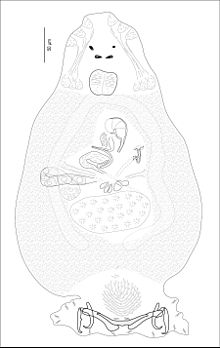
Pseudorhabdosynochus is a genus of monopisthocotylean monogeneans, included in the family Diplectanidae. The type-species of the genus is Pseudorhabdosynochus epinepheli .
Pseudorhabdosynochus huitoe is a diplectanid monogenean parasitic on the gills of the highfin grouper, Epinephelus maculatus. It was described in 2007.
Pseudorhabdosynochus venus is a diplectanid monogenean parasitic on the gills of the grouper Epinephelus howlandi. It has been described in 2006.
Pseudorhabdosynochus cyathus is a diplectanid monogenean parasitic on the gills of the grouper Epinephelus howlandi. It has been described in 2006.
Pseudorhabdosynochus calathus is a diplectanid monogenean parasitic on the gills of the grouper Epinephelus rivulatus. It has been described in 2006.

Pseudorhabdosynochus morrhua is a diplectanid monogenean parasitic on the gills of the grouper Epinephelus morrhua. It has been described in 2008.
Pseudorhabdosynochus variabilis is a diplectanid monogenean parasitic on the gills of the grouper Epinephelus morrhua. It has been described in 2008.
Pseudorhabdosynochus pai is a diplectanid monogenean parasitic on the gills of the greasy grouper, Epinephelus tauvina. It was described in 2009.
Pseudorhabdosynochus justinei is a species of diplectanid monogenean that is parasitic on the gills of the longfin grouper Epinephelus quoyanus. It was described in 2007 by Binjian Zeng and Tingbao Yang from material from the South China Sea, and redescribed in 2009 by Justine, Dupoux & Cribb from material from off Queensland, Australia.
Pseudorhabdosynochus quadratus is a species of diplectanid monogenean that is parasitic on the gills of the white-streaked grouper Epinephelus ongus. It was described in 2011.
Pseudorhabdosynochus crassus is a species of diplectanid monogenean that is parasitic on the gills of the camouflage grouper Epinephelus polyphekadion. It was described in 2011.
Pseudorhabdosynochus dionysos is a species of diplectanid monogenean that is parasitic on the gills of the camouflage grouper Epinephelus polyphekadion. It was described in 2011.
Pseudorhabdosynochus viscosus is a species of diplectanid monogenean that is parasitic on the gills of the camouflage grouper Epinephelus polyphekadion. It was described in 2011.
Pseudorhabdosynochus exoticoides is a species of diplectanid monogenean that is parasitic on the gills of the brownspotted grouper Epinephelus chlorostigma. It was described in 2010.
Pseudorhabdosynochus stigmosus is a species of diplectanid monogenean that is parasitic on the gills of the brownspotted grouper Epinephelus chlorostigma. It was described in 2010.
Pseudorhabdosynochus exoticus is a species of diplectanid monogenean that is parasitic on the gills of the blue grouper Epinephelus cyanopodus. It was described in 2008.
Pseudorhabdosynochus cupatus is a species of diplectanid monogenean parasitic on the gills of groupers.
Pseudorhabdosynochus youngi is species of diplectanid monogenean parasitic on the gills of the blacktip grouper, Epinephelus fasciatus. It was described in 2009.
Pseudorhabdosynochus melanesiensis is a diplectanid monogenean parasitic on the gills of the grouper, Epinephelus merra. It was described in 1958 as Diplectanum melanesiensis then transferred to the genus Pseudorhabdosynochus by Kritsky & Beverley-Burton in 1986.
Pseudorhabdosynochus vagampullum is a species of diplectanid monogenean parasitic on the gills of a grouper. It was described in 1969, from eight specimens, under the name Diplectanum vagampullum and transferred to the genus Pseudorhabdosynochus in 1986. The species has been redescribed several times.



